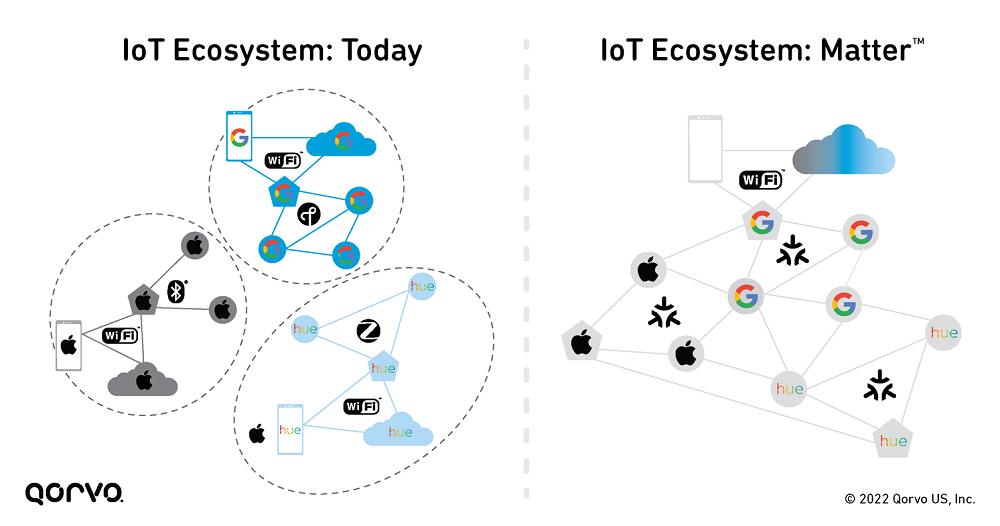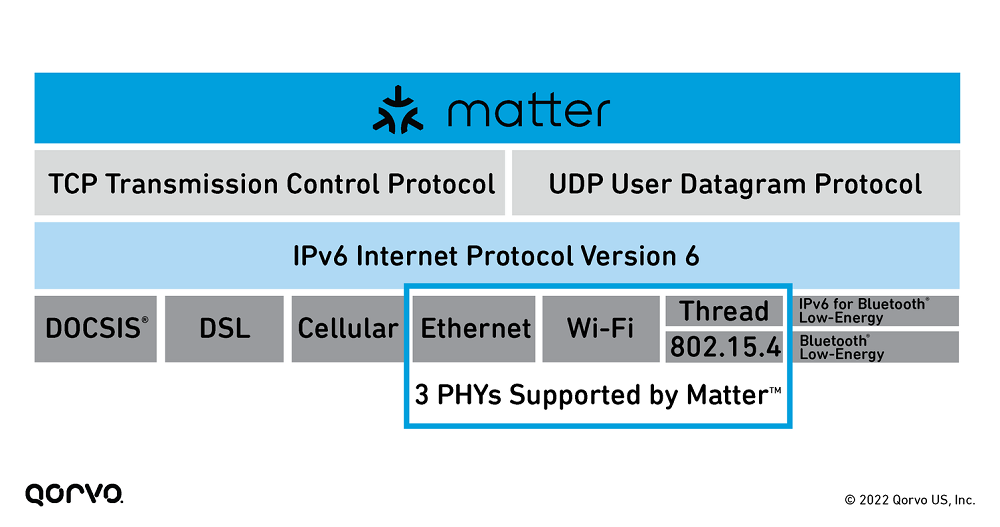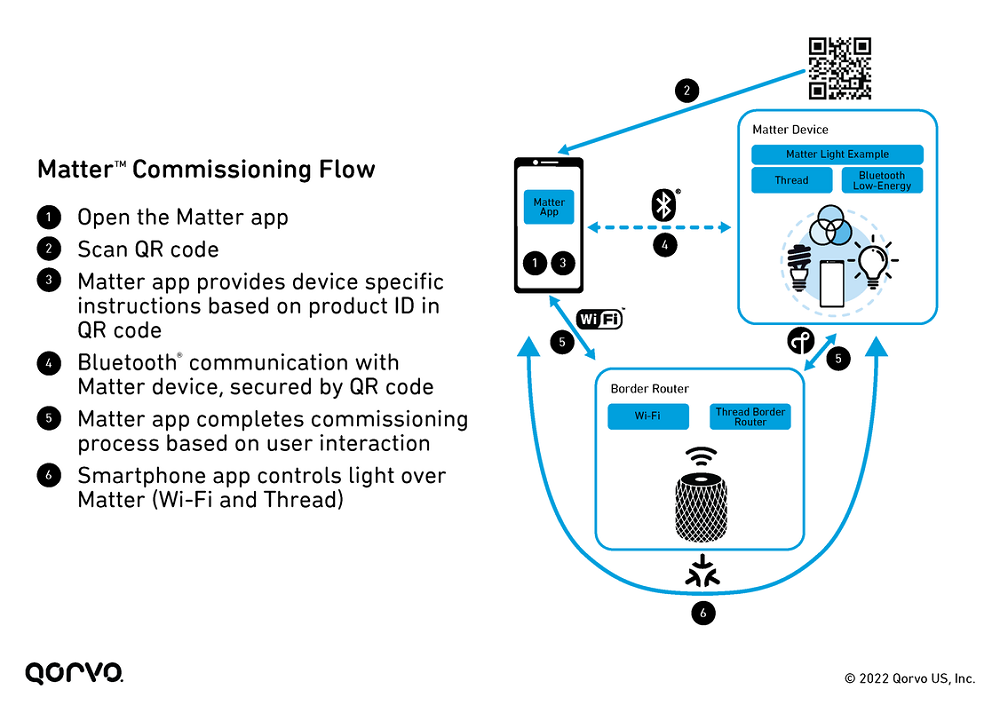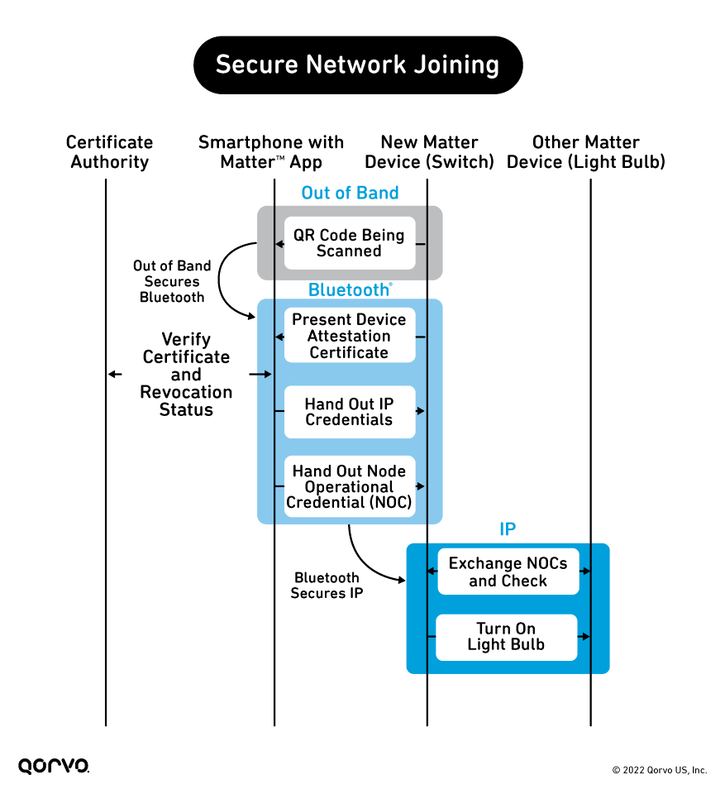Introduction
The new Matter standard will bring interoperability to the IoT ecosystems around us. It's backed by industry leaders who know that standard communication alignment is crucial to mass global acceptance of the IoT. Consumers and business can be confident that products that carry the Matter logo will work seamlessly together today and in the future. No longer will individual wireless ecosystems exist in your home or business, but instead there will only be one IoT ecosystem that communicates seamlessly.
Todays and Tomorrow’s Wireless IoT Ecosystem
Today many IoT ecosystems are like the one on the left side of Figure 1. In the left wireless ecosystem, there are several IoT islands of standards (i.e., Hue, Google, Apple) with an application on the homeowner’s phone to operate each one. There may be some communications between these individual ecosystems. Operating a Nest camera with an Apple iPhone for example, will require bridging and cloud intervention to make that communication happen. This required bridging between devices also hinders innovation because not all data in the home can be easily shared across all devices. In comparison, the Matter ecosystem on the right enables a single network and communication standard for your IoT devices. All of these IoT devices will communicate seamlessly with each other, allowing devices to easily use and act upon events registered by other devices in the network. And from a developer standpoint this is a breath of fresh air because they no longer need to work on bridging in the cloud. They also do not need to create dedicated hubs for each application, because all the devices now speak the same language and are compatible with each other.

Figure 1: Todays and tomorrow's Matter IoT ecosystems.
A Deep Dive into Matter’s Layered Architecture
Matter has a layered architecture, shown in Figure 2. With a physical layer at the bottom, an application layer at the top and several internet protocol (IP) technologies in the middle. The middle transmission control protocol (TCP) and user datagram protocol (UDP), layers are not new and are used for things like surfing the web.
Matter is based on IP technology, IPv6 to be specific (an internet layer protocol for packet-switched internetworking that provides end-to-end datagram transmission across multiple networks), which is integrated in many devices we use each day, such as your laptop and your cell phone. Matter defines a secure application layer on top of the IPv6-based transport protocols, which allows for routing messages regardless of the underlying physical and link layers. It is located on the top application layer of the integration model, looking from the networking point of view.
Using IP means the same language can be spoken with your light bulb as well as the application running on your smartphone and there is no need for translation somewhere in the cloud or in the gateway, which is different than what you have today with Bluetooth or Zigbee. For example, an IP application running on your laptop using Wi-Fi is capable of communicating with any light bulb or Matter enabled device via IP. Additionally, a TV could use its ethernet interface to interact with Matter enabled devices like a Matter lightbulb or it can communicate using Wi-Fi. It’s important to remember since all devices share the same common language (IP) no translation or interpretation of the data through a cloud or gateway is needed.
To facilitate communication with all these different types of devices, Matter supports multiple physical layers. Ethernet and Wi-Fi were already mentioned. Additionally, for improved latency and to enable power efficient battery-powered devices, you can also have Matter over Thread, which is a networking technology that is built on top of 802.15.4. Routing data across these different physical layers is done through a border router, which we discuss in more detail below.

Figure 2: Layered architecture.
An important thing to note here – in Figure 2 above, you see that Bluetooth LE is listed in the bottom layer and is outside the blue box. This is because today, Bluetooth LE in Matter are solely used for commissioning (installing) your devices.
Matter Networking Topology
Because there are three different physical layers in the layered architecture, Matter has introduced the concept of border routers. These border routers contain multiple radios and technologies and are capable of bridging one physical layer to another. A typical border router would speak Wi-Fi and Thread standards, and could be your smart speaker, access point, television, set-top box, etc.
For example, let’s use the scenario of a light bulb with a Thread radio being controlled by a smartphone in Figure 3 below. A Matter message is sent to the access point (AP) using an app on the smartphone (STA) using Wi-Fi. The AP then sends a message to the border router (BR) and the BR then pushes that message to the light bulb (R) to turn on.
Border routers are crucial for your Matter network. The good news is that this border router infrastructure already exists today. Products like Google Nest Wi-Fi and Apple’s HomePod Mini today already integrate the radios that are needed to act as a border router.

Figure 3: Matter network topology.
Matter Commissioning
Matter is touting IoT device simplicity. This is for both developers as well as for customer setup and usage. In the past, adding a new IoT device to your network, known as “device commissioning” or “setup,” has been complex. First off, with Matter there will only be a need for one app on your phone – the Matter app – which will be integrated right in your phone operating system. So right away things are easier because no vendor specific app is needed for controlling and commissioning all your Matter network devices.
As shown in Figure 4 below, the first step, (Step-1) is opening your Matter dashboard in your smartphone. Since Apple and Google are founding members of Matter, they are making certain the smartphone plays a crucial role in the Matter network communications. They are integrating Matter natively in their existing smartphone operating systems. Therefore, smartphones have application programming interface (API) functionality to communicate with all Matter devices. This not only makes things simple for customers purchasing IoT devices, but also makes things simpler for IoT product developers. The next step, (Step-2) will be to scan the QR code on the Matter device you are adding to your network. In Step-3, the smartphone will provide device specific instructions based on the product identification (ID) in the QR code. The app will help drive next steps, like ensuring the device is powered on, as device power on is essential for communications like Bluetooth. While still using the information shared in the QR code, in Step-4 a secure Bluetooth LE communication link is set up between the smartphone and the Matter device. Over the Bluetooth LE link, all information needed to connect to the Matter network at your home is shared. At this point the device is allowed into the Matter network. Then as shown in Step-5, the Matter app completes the commissioning process based on the user app. You’ll then be prompted to choose a room, label device, etc. At this point all communications from the mobile device, access points and Thread border router are complete. Lastly, Step-6, the app on your smartphone can now control the device.

Figure 4: Matter commissioning.
Matter Security
Security is particularly important in the Matter standard. One of its main objectives is to increase security in the network. As shown in Figure 5, it begins this security verification process via the Matter device QR code which allows the device to share its device attestation certificate. The device attestation certificate can be considered the passport for your device and contains information like product ID, vendor ID, manufacturer, etc. A certificate authority decides if the information in the device attestation is legitimate. Once the product is verified, node operational credentials are provided, which is a certificate allowing you to operate the device on your network. The certificate is unique for that specific network. Therefore, the certificate cannot be re-used to operate on another network. Once the node operational credentials are verified and checked, the user can now begin using the secured Matter device.

Figure 5: Matter commissioning and security.
In summary, Matter communications will make our complex fragmented networks less complex to use, more secure and reduce fragmentation. This makes things easier for IoT product developers and users. Developers can more easily develop products that just work without the need for adding cloud-based communications or building dedicated hubs to ensure connectivity. Ultimately this frees up developers to focus on application-level features and helps them develop more innovative products. Additionally, this helps customers benefit from a broader product portfolio and less confusing smart home products that are interoperable and have a common and standardized onboarding procedure.
